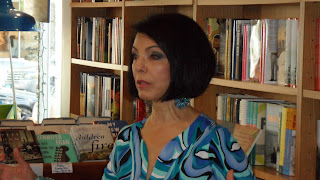 |
| I got to meet Kaling at BEA |
On Day 2 of BEA 2011, Mindy Kaling (best known as Kelly Kapoor and a producer/writer/ of TV's
The Office) hosted the Adult Author Breakfast. Kaling has a book publishing in November titled
Is Everyone Hanging Out Without Me? (And Other Concerns).
Kaling is very funny person, as evidenced by her opening remarks, when she said the audience was sitting there looking at her thinking, "Is that Padma Lakshmi?" "Did she start Google?" and "Is she a Southern state governor?", finishing with "Isn't she a tertiary character on a 4th rate network sitcom?"
She worried about following last year's host Jon Stewart, but she needed have bothered; she was hilarious. She reminded people that she is a "big deal on Twitter, which is the opposite of a book". According to Kaling, Ernest Hemingway would be "a god on Twitter", while "James Joyce would be bad".
According to Kaling, anyone "with a sexy librarian fetish" would enjoy this breakfast, and she had never seen so many "sensible shoes and tote bags." She described the room as "a high school reunion where all the jocks and minorities were killed in a crash". Then she joked that she saw "a black guy, even some straight guys. Oh, they work here at the Javits Center." I laughed heartily at her jokes.
Her book is a series if short essays, with titles like "Don't Peak in High School", "These Are Body Parts I'd Give Up To Be Skinny Forever" and "Why Do Men Put Shoes on Slowly?". She places her literary style between Tina Fey, who has no vices, and Chelsea Handler "who has every vice known to man".
She hopes her book does as well as the three-year-old boy's story
Heaven Is Real, whom she claims is "now friends with Kanye". She said that "so few people have met Jesus, I hope he monetizes the sh#t out of it", which got a huge laugh, as did her line that "
Book TV makes up for
The Kardashians.
Breakfast goers got a short excerpt of her upcoming book, and it is very funny, much in the vein of Tina Fey's
Bossypants. My favorite essay is "Guys Need to Do Almost Nothing To Be Great"; there is a lot of good advice for guys in that essay.
She then introduced "the random panel" who only have in common that "three of us are white, which apparently is important to you guys." Diane Keaton was described by Kaling as "the pinup girl for literate, sensitive men who date women."
Keaton began with "we're gonna slow it down now, my book is a sad book."
Then, Again is the title of her memoir, mostly about her relationship with the most important person in her life, her mother. Keaton spoke lovingly about her mother, who passed away after battling Alzheimer's.
Her mom Dorothy worked at Hunter's Bookstore in Beverly Hills, and Keaton said it was "a great to see such a large group of booksellers." Dorothy wrote her entire life, about being a woman, about going back to school at age 40, and raging against her husband's cancer.
In 1993, she was diagnosed with Alzheimer's, but continued to write everyday , "in sentences, then just words, then just numbers until she couldn't write anymore".
Keaton spoke of never marrying, saying that she dated unattainable men, like Woody Allen, Warren Beatty and Al Pacino. She said "I wanted to be adored by all, yet chose to stay safe in the arms of Dorothy and Jack" (her dad).
While reading from her upcoming book about her mother's battle with Alzheimer's, she broke down and it was a moving, sincere moment. She sobbed noticeably, and the entire room became silent and teary-eyed.
Keaton said that her book is about "what's lost in success contrasted with an ordinary life". I can't wait to read it when it publishes.
Author Jeffrey Eugenides had the unfortunate position of following Keaton, but Kaling introduced him by saying that when she sees a copy of his
Middlesex on a guy's bookshelf, she knows he's OK. She called
Middlesex "a literary canary in my sexual coal mine".
Eugenides became a writer because he "didn't want to get up this early" which elicited a laugh from the audience. He joked about the morning's "trajectory from comedy to Alzheimer's to something sadder- marriage", which is the topic of his upcoming book,
The Marriage Plot.
He described the process of writing this book, where his protagonist Madeline is "besotted with 19th century novels". Most great 19th century novels have marriage as its plot, and Eugenides updates that with his characters, who we meet following college in 1982. It sounds intriguing, but he didn't have anything to share with us, as he just turned it in to his editor the day prior.
I missed the end of the program with author Charlaine Harris, who was the only author to have a complete book to share with everyone, the latest in her Sookie Stackhouse series,
Dead Reckoning. Fans of HBO's
True Blood series have something new to look forward to.














